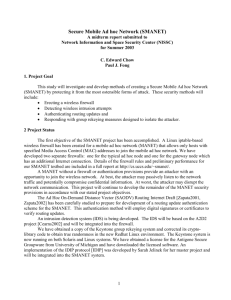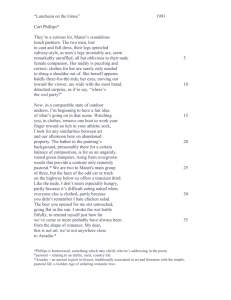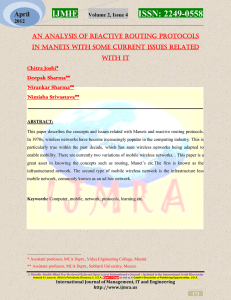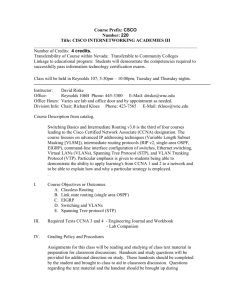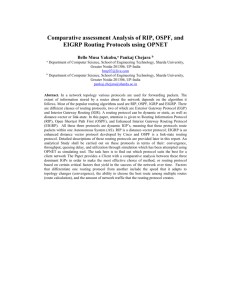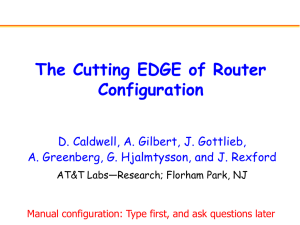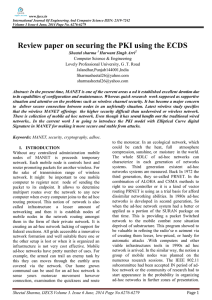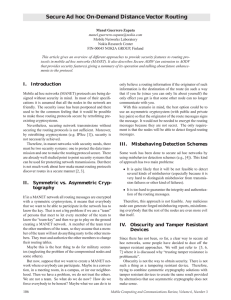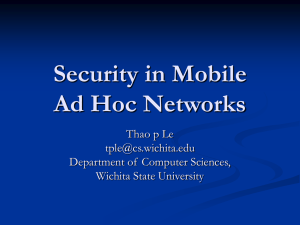Problem Statement for OSPF Extensions for Mobile Ad Hoc
advertisement
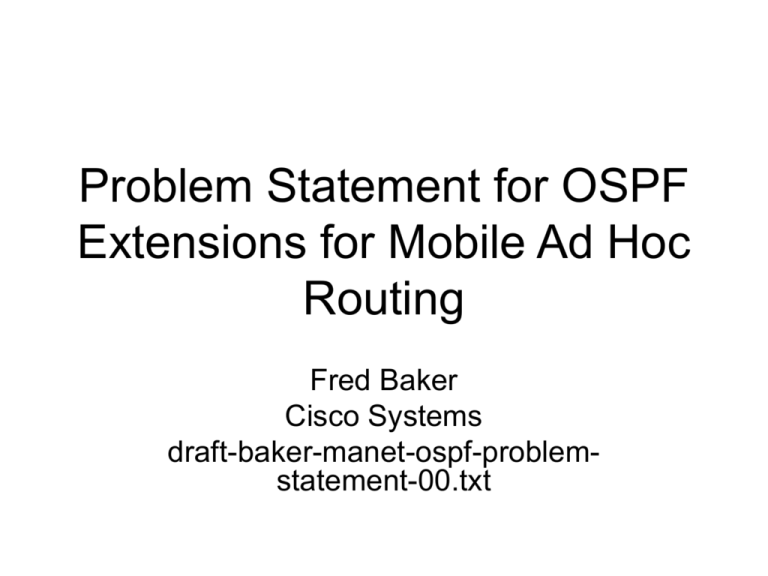
Problem Statement for OSPF Extensions for Mobile Ad Hoc Routing Fred Baker Cisco Systems draft-baker-manet-ospf-problemstatement-00.txt Interesting drafts • Things we think are close: – draft-mirtorabi-ospfv3-af-alt-00.txt – 3 more drafts coming • Related Work – draft-ogier-manet-ospf-extension-00.txt – draft-spagnolo-manet-ospf-wireless-interface00.txt Fundamental Approach • Current target: – US Army WIN-T Network • Design Guidelines – Add a radio interface to OSPF without perturbing existing protocol or capabilities – Using that within a combined radio+wired network • Collaboration between – – – – Cisco folks Inria (OLSR) folks Boeing Research Naval Research Labs Security considerations • Mobile wireless networks prone to physical security threats • Inter-router authentication needed prior to the exchange of network control information. Network design requirements • Manet networks are not often isolated networks • Manet networks often consist of vehicles containing racks with equipment and an internal LAN, or vehicles or robots accompanying groups of people connected to them via wireless LAN technologies and interconnected with other such groups. • Often interspersed with field offices • Connected to a larger internet via standard WAN technologies such as satellite links, optical fiber, or virtual and circuit switched networks. Combining manet and traditional wired networks • Adaptation of both OSPFv2 and OSPFv3 has been considered The big picture Service backbone Such as satcom to Manet cloud Fixed assets Truck addressable Within regional rapid Deployment network Unit-specific Fixed assets Truck addressable Within fixed base Network (802.11) NIPRNET etc Base network Router-to-radio connection System Next-generation 3200 Radio Different rates depending on SNR/BER and radio waveform of connection (potentially many waveforms in same chassis) Key considerations in traffic management • Router-radio interface has what amounts to virtual circuits per neighbor –Shallow txring in radio per routing neighbor –Separate MQC QoS data structures per routing neighbor –Each routing neighbor has a different rate, managed by the radio –Therefore each neighbor must have its own controlled rate protocol between router and radio System PPPOE with extensions Next-generation 3200 JTRS Radio Mobile ad hoc network issues • • • • Often bandwidth-constrained Often power-constrained Limited security Unnecessary transmission is something to be avoided. • Security threats need to be actively addressed, • Transmissions and computation loads need to be minimized. Ad hoc networks • IEEE 802.11? • Choose layer 3 routing over 802.1 bridging? – Network management concerns, – Scaling concerns, – Administrative boundaries • No obvious way to aggregate neighbor sets in the way one does for lans. Relay traffic minimization • Optimizations such as DR election will not perform correctly in MANET networks • How much information needs to be flooded throughout the network? – Ideal solution: each node will receive a particular lsa exactly once – It would be nice if only and exactly one router relayed lsas. – It would be nice to minimize the transmission of lsa acknowledgements Standard OSPF Flooding Overlapping Relays Addressing power issues • Units that rely on batteries may set a policy that they are willing to relay messages on their radio interfaces, but not very willing • May also have LAN interfaces and be willing to relay traffic from radio interfaces on which they are not exchanging even keep-alive traffic to non-radio neighbors at times that their radio interfaces are incommunicado. Scaling for rapid movement • Network should not thrash • If neighbor relationships are changing rapidly, the time invested to become FULL with a peer as defined in OSPF must be minimized, • Efficiently scope the propagation of topology information such that rapid mobility or change in one part of the network need not be disseminated throughout the network. IPv4 and IPv6 routing • OSPF has historically chosen a "ships in the night" model • In mobile ad hoc networks, however, running two protocols in parallel has a heavy impact when the network changes • In mobile ad hoc networks carrying both ipv4 and ipv6 traffic, it would be good for a single routing protocol to calculate one set of routes and decorate those routes with both ipv4 and ipv6 prefixes. Reliable vs unreliable flooding • Problem with unreliable flooding: the assumptions it makes. – Frequent unreliable flooding: limited scalability • Consequences of losing even a single LSA can be great. – Exponential explosions of transmissions, such as can be prohibitively chatty Area hierarchy • No present manet protocol provides a counterpart to OSPF administrative areas. • Some provide dynamic clustering • Not obvious that the hierarchical area model fits proposed manet deployments. • Model permitting summary lsas exchange at any boundary preferable Problem Statement for OSPF Extensions for Mobile Ad Hoc Routing Fred Baker Cisco Systems draft-baker-manet-OSPFproblem-statement-00

